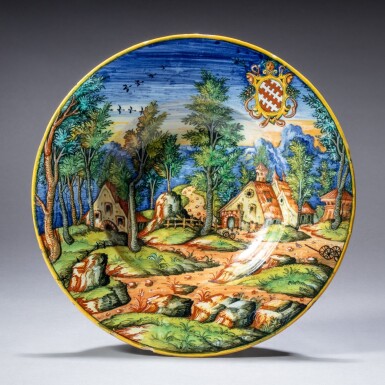
Workshop of Guido Durantino (Fontana), from the Salviati service
Istoriato Plate
Estimate
12,000 - 18,000 EUR
Lot Details
Description
Italian, Urbino, circa 1559
painted with a landscape and the arms of Salviati, in green, blue, yellow, orange, grey, brown, purple-black, white. On the reverse yellow rings, the inventory number 7.2945 in modern ink.
tin-glazed earthenware (maiolica)
Diam. 27cm.; 10⅝in.
Jacopo di Alamanno Salviati (1537-1586);
Possibly his son, Lorenzo, Marquis of Giuliano (1568-1609);
His second son, Jacopo di Lorenzo, Duke of Giuliano (1607-1672), and possibly by descent to Francesco Maria di Jacopo Salviati (1629-1698), and Anton Maria di Francesco Maria Salviati (d.1704);
Christie’s London, 6 December 1971, lot 80;
Where acquired.
This plate is part of an extensive armorial service commissioned by the Salviati family, one of the wealthiest and most influential aristocratic families in Florence who were closely linked to the ruling Medici through marriage. The service is unique in that it was almost entirely composed of landscapes, with few or only minor figures and no narrative scenes. The Salviati arms stand out against the blue sky, above the landscape, within an oval shield with a strap-work scrolling frame surmounted by a mask.
The occasion for the commission of such a large service was probably the marriage of Jacopo Salviati with his cousin Isabella Salviati in 1559, a plausible date for the style of these plates, and the service was most likely a gift to them.
These plates were almost certainly executed and painted in the workshop of the leading maiolica manufacturer in Urbino at the time, the Fontana family, perhaps by the same painter as the Punic War Series (see lot 618, online sale).
The subject of the plates in the Salviati service is nature, the landscape, with blue mountains in the distance and no visible human except for the alpine-like thatched roof cottages amidst the trees. The compositions were clearly influenced by the work of German printmakers, but no precise derivation has been determined.
The Venetian School of both painting and printmaking, from Giovanni Bellini, Giorgione and Titian to the engraver Domenico Campagnola, developed a particular love for the Alpine landscape and included buildings with typically northern steep thatched roofs.
The documentation of this service has been published by Michael Brody, and the 1583 inventory in the Archivio Salviati in Pisa describes in detail what is apparently the original configuration of the 178 pieces listed which included: four large jugs; four wine coolers; twenty-four large plates; 146 plates or bowls four of smaller sizes. The Salviati service seems to have been designed as a table setting for a party of twenty-four diners.
RELATED LITERATURE
T. Wilson, The Golden Age of Italian Maiolica - Painting Catalogue of a private collection, Turino, 2018, no. 141, pp. 141-142;
M. J. Brody "`Terra d'Urbino tutta dipinta a paesi con l'armi de' Salviati': the paesi service in the 1583 inventory of Jacopo di Alamanno Salviati (1537-1586)", Faenza 86, 2000, nos. 4-6, pp. 30-46.
You May Also Like










